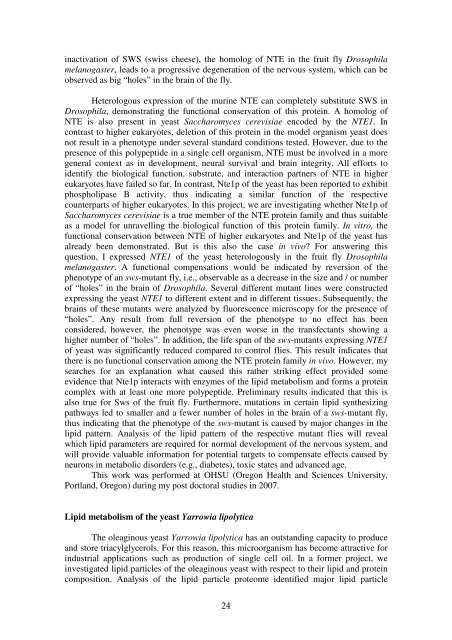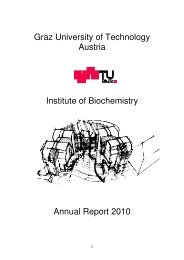Staff Members of the Institute of Biochemistry, TU Graz http://www ...
Staff Members of the Institute of Biochemistry, TU Graz http://www ...
Staff Members of the Institute of Biochemistry, TU Graz http://www ...
Create successful ePaper yourself
Turn your PDF publications into a flip-book with our unique Google optimized e-Paper software.
inactivation <strong>of</strong> SWS (swiss cheese), <strong>the</strong> homolog <strong>of</strong> NTE in <strong>the</strong> fruit fly Drosophila<br />
melanogaster, leads to a progressive degeneration <strong>of</strong> <strong>the</strong> nervous system, which can be<br />
observed as big “holes” in <strong>the</strong> brain <strong>of</strong> <strong>the</strong> fly.<br />
Heterologous expression <strong>of</strong> <strong>the</strong> murine NTE can completely substitute SWS in<br />
Drosophila, demonstrating <strong>the</strong> functional conservation <strong>of</strong> this protein. A homolog <strong>of</strong><br />
NTE is also present in yeast Saccharomyces cerevisiae encoded by <strong>the</strong> NTE1. In<br />
contrast to higher eukaryotes, deletion <strong>of</strong> this protein in <strong>the</strong> model organism yeast does<br />
not result in a phenotype under several standard conditions tested. However, due to <strong>the</strong><br />
presence <strong>of</strong> this polypeptide in a single cell organism, NTE must be involved in a more<br />
general context as in development, neural survival and brain integrity. All efforts to<br />
identify <strong>the</strong> biological function, substrate, and interaction partners <strong>of</strong> NTE in higher<br />
eukaryotes have failed so far. In contrast, Nte1p <strong>of</strong> <strong>the</strong> yeast has been reported to exhibit<br />
phospholipase B activity, thus indicating a similar function <strong>of</strong> <strong>the</strong> respective<br />
counterparts <strong>of</strong> higher eukaryotes. In this project, we are investigating whe<strong>the</strong>r Nte1p <strong>of</strong><br />
Saccharomyces cerevisiae is a true member <strong>of</strong> <strong>the</strong> NTE protein family and thus suitable<br />
as a model for unravelling <strong>the</strong> biological function <strong>of</strong> this protein family. In vitro, <strong>the</strong><br />
functional conservation between NTE <strong>of</strong> higher eukaryotes and Nte1p <strong>of</strong> <strong>the</strong> yeast has<br />
already been demonstrated. But is this also <strong>the</strong> case in vivo For answering this<br />
question, I expressed NTE1 <strong>of</strong> <strong>the</strong> yeast heterologously in <strong>the</strong> fruit fly Drosophila<br />
melanogaster. A functional compensations would be indicated by reversion <strong>of</strong> <strong>the</strong><br />
phenotype <strong>of</strong> an sws-mutant fly, i.e., observable as a decrease in <strong>the</strong> size and / or number<br />
<strong>of</strong> “holes” in <strong>the</strong> brain <strong>of</strong> Drosophila. Several different mutant lines were constructed<br />
expressing <strong>the</strong> yeast NTE1 to different extent and in different tissues. Subsequently, <strong>the</strong><br />
brains <strong>of</strong> <strong>the</strong>se mutants were analyzed by fluorescence microscopy for <strong>the</strong> presence <strong>of</strong><br />
“holes”. Any result from full reversion <strong>of</strong> <strong>the</strong> phenotype to no effect has been<br />
considered, however, <strong>the</strong> phenotype was even worse in <strong>the</strong> transfectants showing a<br />
higher number <strong>of</strong> “holes”. In addition, <strong>the</strong> life span <strong>of</strong> <strong>the</strong> sws-mutants expressing NTE1<br />
<strong>of</strong> yeast was significantly reduced compared to control flies. This result indicates that<br />
<strong>the</strong>re is no functional conservation among <strong>the</strong> NTE protein family in vivo. However, my<br />
searches for an explanation what caused this ra<strong>the</strong>r striking effect provided some<br />
evidence that Nte1p interacts with enzymes <strong>of</strong> <strong>the</strong> lipid metabolism and forms a protein<br />
complex with at least one more polypeptide. Preliminary results indicated that this is<br />
also true for Sws <strong>of</strong> <strong>the</strong> fruit fly. Fur<strong>the</strong>rmore, mutations in certain lipid syn<strong>the</strong>sizing<br />
pathways led to smaller and a fewer number <strong>of</strong> holes in <strong>the</strong> brain <strong>of</strong> a sws-mutant fly,<br />
thus indicating that <strong>the</strong> phenotype <strong>of</strong> <strong>the</strong> sws-mutant is caused by major changes in <strong>the</strong><br />
lipid pattern. Analysis <strong>of</strong> <strong>the</strong> lipid pattern <strong>of</strong> <strong>the</strong> respective mutant flies will reveal<br />
which lipid parameters are required for normal development <strong>of</strong> <strong>the</strong> nervous system, and<br />
will provide valuable information for potential targets to compensate effects caused by<br />
neurons in metabolic disorders (e.g., diabetes), toxic states and advanced age.<br />
This work was performed at OHSU (Oregon Health and Sciences University,<br />
Portland, Oregon) during my post doctoral studies in 2007.<br />
Lipid metabolism <strong>of</strong> <strong>the</strong> yeast Yarrowia lipolytica<br />
The oleaginous yeast Yarrowia lipolytica has an outstanding capacity to produce<br />
and store triacylglycerols. For this reason, this microorganism has become attractive for<br />
industrial applications such as production <strong>of</strong> single cell oil. In a former project, we<br />
investigated lipid particles <strong>of</strong> <strong>the</strong> oleaginous yeast with respect to <strong>the</strong>ir lipid and protein<br />
composition. Analysis <strong>of</strong> <strong>the</strong> lipid particle proteome identified major lipid particle<br />
24














